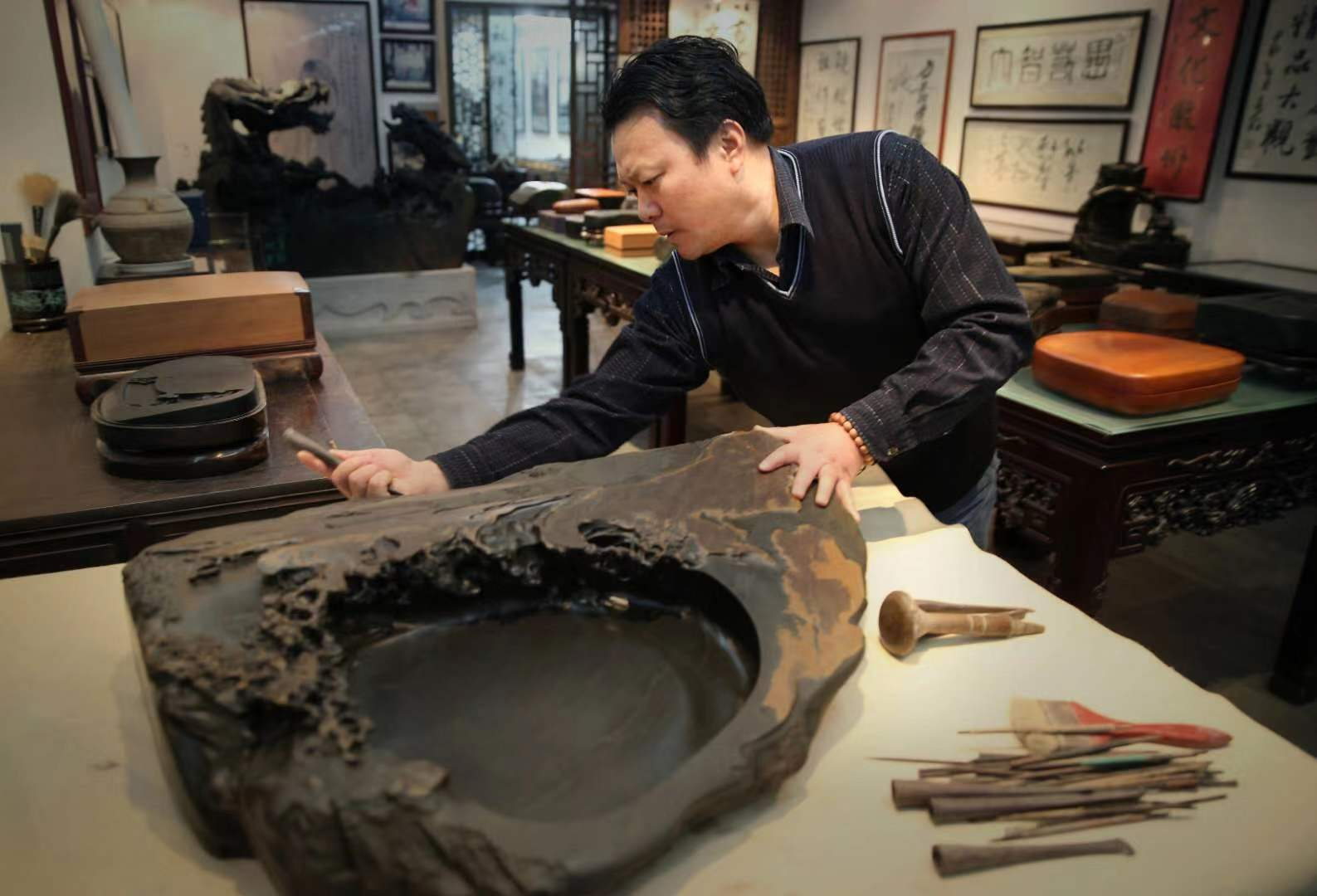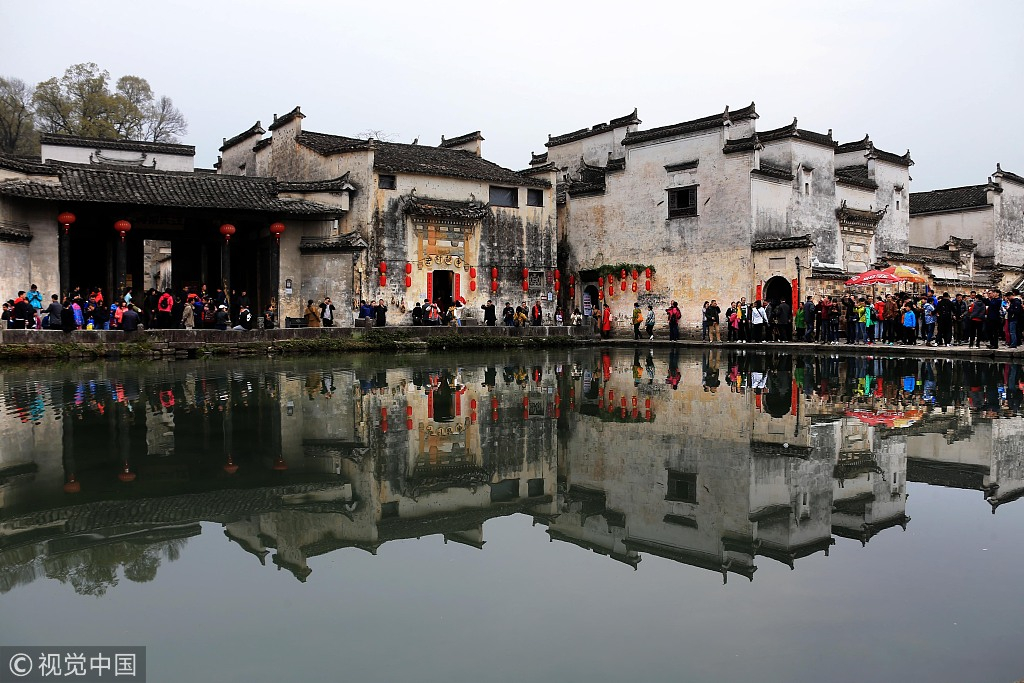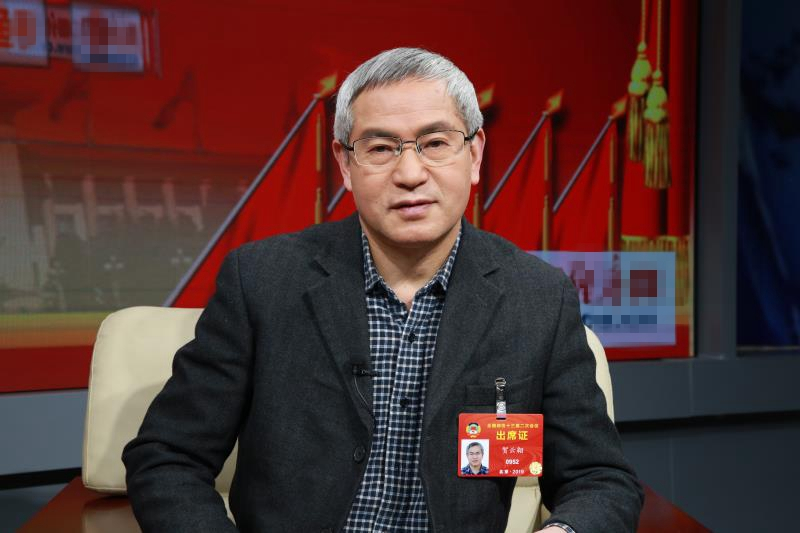
Culture
10:53, 16-Mar-2019
Protection: Making intangible cultural heritage tangible
Updated
22:21, 16-Mar-2019
By Wu Yan
04:43

"We have to show our intangible cultural heritages and let people experience them and experience the culture behind them, otherwise people would not truly know them," said Wang Zuwei, a deputy to the 13th National People's Congress and inheritor of a national intangible cultural heritage – She inkstone crafts.
Intangible cultural heritage, according to UNESCO, includes traditions inherited from our ancestors and passed on to our descendants, like making inkstone. Inkstone is a hand-made stone used by ancient Chinese people to grind ink before writing or painting with a brush.
Born in She County, Huangshan City, Wang started his lifelong career on She inkstone at 18, and currently owned a shop in Tunxi Old Street in Huangshan, to display and sell his works.
"Many tourists who come to Huangshan want to buy She inkstones as collection or gift," he said. "I feel that people recognize traditional culture more, and this trend is accumulating."
She inkstone, as one of four most famous inkstones in China, refers to inkstones that made out of stones produced in ancient Shezhou region, now divided into Huangshan City and Jixi County both in Anhui Province, and Wuyuan County in Jiangxi Province.

Wang Zuwei makes a She inkstone in Huangshan City, Anhui Province. /Photo provided by Wang Zuwei
Wang Zuwei makes a She inkstone in Huangshan City, Anhui Province. /Photo provided by Wang Zuwei
On China's leading consumer review site dianping.com, a visitor to Wang's shop saw Wang making inkstone onsite and posted, "For the first time in my life, I learned some common knowledge about inkstone. It is very interesting."
To encourage more people to learn about traditional culture and to exhibit and pass on more efficiently, during the Two Sessions this year, Wang proposed that the central government support Huangshan City to hold the first national-level world heritages forum and the fourth intangible culture heritage traditional crafts exhibition.
Huangshan City boasts two world heritage sites, two UNESCO intangible cultural heritages, 20 national intangible cultural heritages, and 33 national intangible cultural heritage inheritors.
In 2008, the pilot program called Huizhou State Reserve of Cultural Ecology was established, to protect local intangible cultural heritages and the human and natural environment that fostered such heritages.

Hui style architectures in Hongcun Village, Anhui Province, March 25, 2018. /VCG Photo
Hui style architectures in Hongcun Village, Anhui Province, March 25, 2018. /VCG Photo
"The intangible culture heritage traditional crafts exhibition is a product of the pilot Huizhou State Reserve of Cultural Ecology," said Wang. Last year's annual exhibition attracted 50 national intangible cultural heritages across the country to be exhibited and showcased.
Wang said that after (Huizhou) State Reserve of Cultural Ecology was built, people have been drawn to experience the culture and developed an interest in it, which had a deep impact on cultural productivity and the export of our traditional culture.
"In recent years, people's yearn for good life and culture have become stronger," said He Yun'ao, a member of the 13th Chinese People's Political Consultative Conference (CPPCC) National Committee and director of the Institute of Cultural and Natural Heritage of Nanjing University. "Traditional culture has entered into many households and become an important part of people's lives."

He Yun'ao, a member of the 13th CPPCC National Committee and director of the Institute of Cultural and Natural Heritage of Nanjing University, in Beijing, March 8, 2019. /Photo provided by He Yun'ao
He Yun'ao, a member of the 13th CPPCC National Committee and director of the Institute of Cultural and Natural Heritage of Nanjing University, in Beijing, March 8, 2019. /Photo provided by He Yun'ao
Fifteen years have past since China officially joined the UNESCO Convention for the Safeguarding of the Intangible Cultural Heritage. The country currently has 40 inscribed elements on the world's intangible cultural heritage list of UNESCO, more than any other country.
"China's protection in intangible cultural heritages has achieved great progress, but it should have a higher pursuit and go up to a higher level," said He. "And state reserves of cultural ecology are just an important way to enhance the level of protecting and utilizing intangible cultural heritages."
Since the first pilot Southern Fujian State Reserve of Cultural Ecology was set up in 2007, a total of 21 such pilot state reserves and 146 pilot provincial reserves of cultural ecology have been set up across the country. On March 1, a regulation on the establishment and operation of state reserves of cultural ecology came into force, making China's decade-long exploration standardized.

Fishing in Hongze Lake, Jiangsu Province, June 14, 2011. The pilot Hongze Lake provincial reserve of fishing cultural ecology was established in 2011. /VCG Photo
Fishing in Hongze Lake, Jiangsu Province, June 14, 2011. The pilot Hongze Lake provincial reserve of fishing cultural ecology was established in 2011. /VCG Photo
He himself participated in the research, plan and approval of some of the pilot provincial reserves of cultural ecology in Jiangsu Province. He found that it is a challenge to make all local people respect intangible cultural heritages without sabotaging them, to protect them in their original forms.
He suggested to build a three-level reserves of cultural ecology from city, to province and to state, in order to provide good conditions to protect intangible cultural heritages integrally. "It will promote the rational use of heritages and develop into characteristic local cultural industries, facilitate the rural modernization by integrating heritages with tourism, and realize the creative transformation and development of cultural resources," he said.
"Although focusing on protecting intangible cultural heritages, the reserves aim to benefit people," said He.
Videographer: Geng Zhibin
Video Editor: Lv Jiarong, Zhong Jianli
Top Image Designer: Li Xiaojie
Copy Editor: Bryan Pirolli, Josh McNally
Chief Editor: Wang Dongmei, Xu Jian

SITEMAP
Copyright © 2018 CGTN. Beijing ICP prepared NO.16065310-3
Copyright © 2018 CGTN. Beijing ICP prepared NO.16065310-3